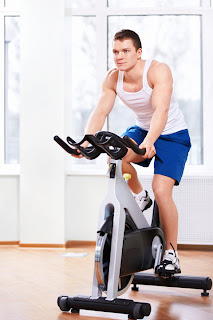Today we are going to be looking into HIIT to help you get more from your workouts. Too many fitness enthusiasts suffer unnecessary setbacks in the gym because they are not taking the time to weigh up the possible risks beforehand.
Whether it's using creatine supplements without researching, or trying weights without learning the correct technique, the gym can be a dangerous place if you don't learn the ropes.
Like all forms of training, interval training comes with a certain element of risk and it should be assessed before you attempt it.
The overwhelming majority of gym users who wish to adopt this method into their workout program are more interested in the potential fat loss benefits it could yield. However, it would be foolish to jump in without first addressing the two most common risks. They are:
1) How many times per week should you perform interval training?
2) How can you avoid unnecessary injuries?
One of the biggest myths of the gym is that more training means better results. This myth was born in the early 1980's with the rise of the aerobics home workout phenomenon. People would perform long, drawn out cardio workouts every single day. If you adopt this approach here, however, you will damage your own results.
You may have heard that the top fat loss benefit of interval training is EPOC, also known as the afterburn. This is the process by which your body will continue to burn off more calories after your leave the gym. It lasts for up to fourteen hours in total, meaning you should allow adequate rest between each workout if you want to get the most from this desirable phase. Because of this recovery period it is recommended that you perform no more than three hit workouts in any given week.
Injuries are also quite common with interval training. This is down to the explosive nature of the exercises being performed and it usually comes down to participants neglecting their warm up period. Under no circumstances should you try to perform this type of physical activity if you are not sufficiently warmed up.
A warm-up need only take five minutes and the benefits are clear. However, we live in an impatient world where folks want to get in and out of the gym as quickly as humanly possible and this sometimes means skipping the warm-up and cool-down sessions. Much like if you tried using whey protein or creatine supplements without researching them first. this only comes back to haunt you and your hiit sessions will suffer as a result.
Whether it's using creatine supplements without researching, or trying weights without learning the correct technique, the gym can be a dangerous place if you don't learn the ropes.
Like all forms of training, interval training comes with a certain element of risk and it should be assessed before you attempt it.
The overwhelming majority of gym users who wish to adopt this method into their workout program are more interested in the potential fat loss benefits it could yield. However, it would be foolish to jump in without first addressing the two most common risks. They are:
1) How many times per week should you perform interval training?
2) How can you avoid unnecessary injuries?
One of the biggest myths of the gym is that more training means better results. This myth was born in the early 1980's with the rise of the aerobics home workout phenomenon. People would perform long, drawn out cardio workouts every single day. If you adopt this approach here, however, you will damage your own results.
You may have heard that the top fat loss benefit of interval training is EPOC, also known as the afterburn. This is the process by which your body will continue to burn off more calories after your leave the gym. It lasts for up to fourteen hours in total, meaning you should allow adequate rest between each workout if you want to get the most from this desirable phase. Because of this recovery period it is recommended that you perform no more than three hit workouts in any given week.
Injuries are also quite common with interval training. This is down to the explosive nature of the exercises being performed and it usually comes down to participants neglecting their warm up period. Under no circumstances should you try to perform this type of physical activity if you are not sufficiently warmed up.
A warm-up need only take five minutes and the benefits are clear. However, we live in an impatient world where folks want to get in and out of the gym as quickly as humanly possible and this sometimes means skipping the warm-up and cool-down sessions. Much like if you tried using whey protein or creatine supplements without researching them first. this only comes back to haunt you and your hiit sessions will suffer as a result.
By Russ Hollywood
About the Author:
About the Author:
About the author: To get more details on how to use hiit and using supplements like creatine for optimum results, be sure to pick up Russ Howe PTI's comprehensive free guides which have already helped thousands of fitness entusiaststs worldwide.

